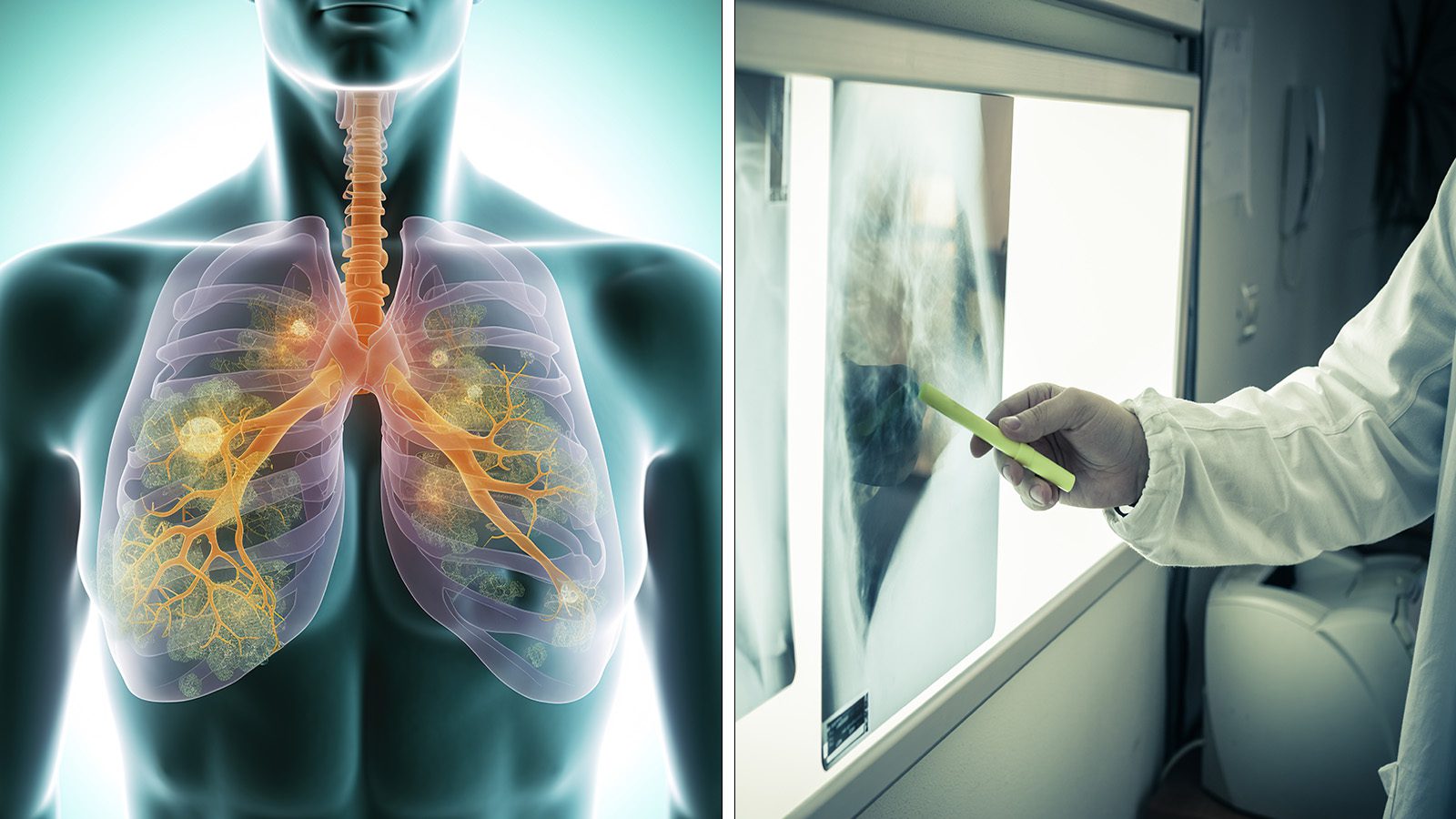Here are the early signs of cancer of the lungs.
Regarding our health, understanding and awareness are our greatest allies. Lung cancer rates among the leading causes of cancer-related deaths worldwide. It’s a condition that can quietly progress, showing few noticeable symptoms in its early stages. That is why recognizing the subtle signs becomes crucial. In this article, we delve into the silent symptoms of lung cancer – the ones that are easy to overlook but vital to notice. The goal is to empower you with knowledge, helping you understand when these symptoms could signal something more serious than a common ailment.
Understanding Lung Cancer
Lung cancer comes from the uncontrolled growth of abnormal cells in one or both lungs, primarily affects the cells lining the air passages. It’s categorized into two main types:
- Non-Small Cell Lung Cancer (NSCLC)
- Small Cell Lung Cancer (SCLC)
NSCLC is the most common type.

According to the National Cancer Institute, lung cancer causes one in five cancer-related deaths in the United States, surpassing both breast, colon, and prostate cancer combined.
The causes of lung cancer are varied, though smoking remains the leading risk factor, accounting for a significant number of cases. Exposure to secondhand smoke, radon gas, asbestos, and other carcinogens also plays a role. However, it’s crucial to note that lung cancer can also develop in non-smokers, indicating that other environmental and genetic factors are at play.
One of the challenges in battling lung cancer is its silent progression. Often, symptoms don’t become apparent until the disease has advanced. This delay in detection makes understanding and recognizing early signs all the more important. These symptoms could easily be mistaken for less serious conditions, leading to misdiagnosis or delayed treatment.
The American Lung Association explains how only 5.8% of eligible people received lung cancer screenings. But that is important, as early-stage lung cancer patients have a significantly higher five-year survival rate compared to those diagnosed at a later stage.
10 Symptoms of Lung Cancer That Many People Miss
This article will outline the ten silent symptoms of lung cancer that nobody should ever ignore. These signs can be the key to early detection and, consequently, more effective treatment. Remember that your awareness and proactive approach to health can make a monumental difference.
Symptom 1: Persistent Cough May Indicate Lung Canter
A persistent cough is one of the most common but easily dismissed symptoms. It’s natural to overlook a cough, especially during certain seasons, or under the assumption it’s linked to a benign condition like a cold. However, it’s worth paying attention to if you notice a cough that lingers beyond the usual span of a common cold or flu – typically lasting more than two weeks.
This persistent cough associated with lung cancer may differ from a regular cough. It might be more chronic, deeper, and at times painful. The cough may also change in character, perhaps becoming hoarser or producing blood or an unusual amount of mucus. Coughing up blood (hemoptysis) occurs in some lung cancer cases. However, even without blood, any persistent change like your cough should prompt a visit to the doctor.
Understanding the difference between a simple cough and one that warrants medical attention is key. A cough related to a cold or allergies often improves or resolves within a couple of weeks, while a cough from lung cancer persists or worsens over time.
Symptom 2: Changes in Breathing
Shortness of breath or changes in breathing patterns can also be a subtle sign of lung cancer. These changes often go unnoticed because they can be gradual or attributed to factors like age, fitness level, or other health conditions. However, if you find yourself becoming easily winded or experiencing shortness of breath during activities that didn’t pose a challenge before, it could be a sign of lung cancer.
Lung cancer can obstruct or narrow the airways or cause fluid from a tumor to build up in the chest. As a result, it becomes harder to breathe. This symptom is particularly noteworthy if it occurs without any obvious cause, such as physical exertion or a respiratory illness. Wheezing, or a whistling sound when you breathe, can also reveal lung cancer, although it’s more commonly associated with conditions like asthma or bronchitis.
A doctor should evaluate any new, unexplained, or worsening breathing difficulties. It’s important to note that these symptoms can also indicate other health conditions. Therefore, a thorough medical exam is essential to determine the cause.
Symptom 3: Chest Pain Can Mean Lung Cancer
Chest pain is a symptom that is always taken seriously, and in the context of lung cancer, it holds specific significance. Individuals with lung cancer might experience pain in their chest, shoulders, or back. This pain isn’t intermittent, like what you might feel with a strained muscle or after physical exertion. Instead, it is a constant ache that may be exacerbated by deep breathing, coughing, or laughing.
The pain arises as the cancerous cells grow and invade tissue in and around the lungs or when it spreads to the bones in the chest and spine. Chest pain related to lung cancer may be dull, sharp, or on and off. Regardless, it is persistently present. It’s a type of pain distinctly different from a muscle pull or a heartburn sensation and shouldn’t be overlooked.
If you experience persistent chest pain, particularly if it’s localized and not alleviated by over-the-counter pain medications or rest, it’s important to consult with a healthcare professional. This kind of chest pain can be a sign of advanced lung cancer, and early detection can be vital for treatment efficacy.
Symptom 4: Weight Loss and Appetite Changes
Unintended weight loss and changes in appetite are symptoms that are often associated with cancer in general, including lung cancer. If you’re losing weight without changes in your diet or exercise routine, it could be a cause for concern. This type of weight loss, often described as an unexplained loss of ten or more pounds, can be a sign of lung cancer.
Cancer cells can consume much of the body’s energy; the immune system also uses energy to fight the disease. Thus, it can lead to weight loss. Also, lung cancer may affect metabolism and alter how the body processes food and energy. Appetite changes, such as less interest in food or feeling full quickly, can also contribute to weight loss.
The Cleveland Clinic emphasizes that unexplained weight loss and changes in appetite are symptoms that should never be ignored. These can be indicative of lung cancer, especially in conjunction with other symptoms we’ve discussed. It’s critical to consult your doctor if you experience significant weight loss without trying, as it might indicate an underlying health issue.
Symptom 5: Fatigue
Fatigue is a common symptom in many people’s lives, often attributed to busy lifestyles, stress, or lack of sleep. However, when fatigue becomes overwhelming and isn’t relieved by rest, it warrants closer attention, as it can be a silent symptom of lung cancer. This kind of fatigue is more than just feeling tired; it’s an extreme form of exhaustion that doesn’t improve with rest and can significantly impact daily activities.
The mechanism behind cancer-related fatigue is complex. It may be due to the cancer cells consuming much of the body’s energy, the immune system’s heightened activity to fight the cancer, or the release of certain chemicals by the cancer that affect energy levels. Additionally, lung cancer can lead to decreased oxygen levels in the blood, contributing further to feelings of tiredness or weakness.
Fatigue is a common symptom in many conditions. Still, persistent, unexplained fatigue should be evaluated. Suppose you feel constantly worn out, unable to perform tasks that were once easy, or disproportionately tired about your activity level. In that case, it’s important to talk to a healthcare professional.
Symptom 6: Recurring Infections Could Reveal Lung Cancer
While anyone can experience infections like bronchitis or pneumonia, recurring respiratory infections can indicate lung cancer. This happens because lung cancer can block or narrow the airways, leading to repeated lung infections. Suppose you’re experiencing frequent bronchitis, pneumonia, or other respiratory infections, particularly if they recur in the same lung area. In that case, it’s a symptom worth discussing with your doctor.
Repeated lung infections or lingering pneumonia that doesn’t resolve with treatment should be investigated further. It’s important to differentiate between common respiratory infections that resolve with typical treatment and those that are persistent, as the latter could be a red flag for lung cancer.
It’s not uncommon for lung cancer to be initially misdiagnosed as a recurring infection. Therefore, if you have a history of smoking or exposure to other risk factors and you’re experiencing repeated respiratory infections, a thorough medical evaluation, including imaging tests, might be warranted.
Symptom 7: Hoarseness
Hoarseness or a noticeable change in your voice can be another subtle symptom of lung cancer. This change typically occurs when a lung tumor affects the nerve controlling the larynx or voice box. It might start as a slight raspiness or change in tone and can progress to a significant alteration in the sound of your voice. While hoarseness is a common symptom associated with conditions like laryngitis or colds, it warrants further investigation if it persists for more than two weeks without an apparent cause.
A hoarse throat is particularly important to note if you haven’t been experiencing a sore throat or a cold that typically leads to voice changes. If your voice remains hoarse over an extended period, or if you have other risk factors for lung cancer, it’s advisable to seek a medical evaluation.
Symptom 8: Swelling in the Face or Neck
Swelling in the face or neck can be a less known yet significant symptom of lung cancer. This swelling, superior vena cava syndrome, occurs when a lung tumor presses against the superior vena cava, the large vein moving blood from the upper body to the heart. The pressure can lead to a buildup of blood in the vessels of the face and neck. As a result, it can cause noticeable swelling.
According to the Cleveland Clinic, superior vena cava syndrome symptoms can include the following:
- Swelling in the face, neck, upper chest, and arms
- Redness
- Visible veins.
This condition can develop gradually or suddenly and requires prompt medical attention. While other conditions can cause superior vena cava syndrome, its association with lung cancer makes it a critical symptom to be aware of.
If you experience unexplained swelling in these areas, especially if accompanied by other symptoms of lung cancer, consult a healthcare professional immediately. This symptom can indicate an advanced stage of the disease, and early intervention can be crucial for effective treatment and symptom management.
Symptom 9: Persistent Chest, Shoulder, or Back Pain
Persistent pain in the chest, shoulder, or back can be another indicator of lung cancer. This pain is not the typical, fleeting discomfort associated with muscular strain or minor injury; it’s a constant and lingering pain that may be difficult to pinpoint or describe. Lung cancer can cause pain in these areas due to the growth of the tumor in the lung tissue and surrounding areas or when cancer spreads to the bones.
The Mayo Clinic states that while back and shoulder pain are common, persistent pain in these areas can be serious. It differs from sore muscles or typical joint or bone pain, often described as a deep, aching, or dull pain.
Pay attention to this type of pain, especially if it’s unexplained and doesn’t improve with typical treatments like rest or heat. If you experience such symptoms, it’s advisable to undergo a thorough medical evaluation. That exam will help the doctor determine the underlying cause.
Symptom 10: Changes in the Appearance of Fingers
A lesser-known symptom of lung cancer is the change in the appearance of fingers, a condition known as “clubbing.” Clubbing involves changes in the areas under and around the fingernails and can result in the fingertips becoming larger or more rounded. It’s a subtle change that occurs gradually and is often overlooked.
Clubbing is thought to be related to changes in the amount of oxygen in the blood. Lung cancer can affect lung function and blood oxygen levels, leading to these distinctive finger changes. Cancer researchers note that while clubbing is not exclusive to lung cancer and can be associated with other conditions, it’s a symptom that should not be ignored, especially if it occurs alongside other lung cancer symptoms.
If you notice that your fingertips are becoming more rounded, your nails are more curved than usual, or the skin around your nails is changing, it’s important to consult a healthcare professional. These changes in your fingers can provide critical clues to your overall health, including the possibility of lung cancer.
Final Thoughts: Knowing the Signs of Lung Cancer Can Save a Life
While the symptoms of lung cancer can be subtle and easily mistaken for less serious health issues, awareness and vigilance can be life-saving. The signs we’ve discussed are crucial indicators of this disease. Do not ignore or overlook them! Lung cancer, when you find it early, is more likely to be treatable and potentially curable.






















